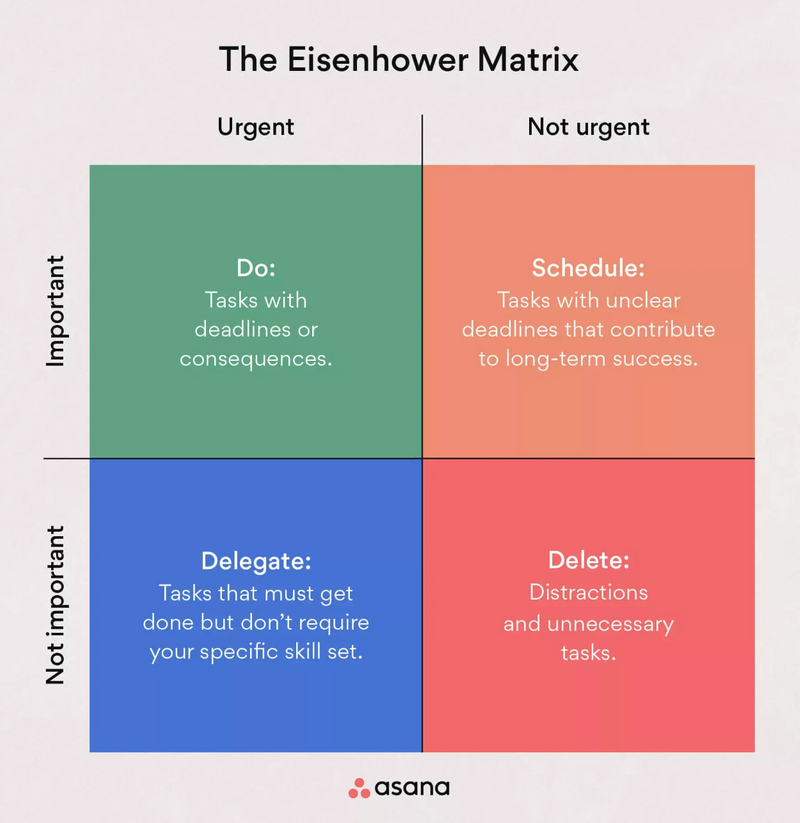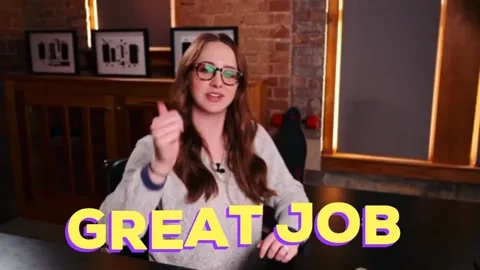
This logo isn't an ad or affiliate link. It's an organization that shares in our mission, and empowered the authors to share their insights in Byte form.
Rumie vets Bytes for compliance with our
Standards.
The organization is responsible for the completeness and reliability of the content.
Learn more
about how Rumie works with partners.
You’re at a job interview, and the interviewer asks, "How do you balance multiple priorities?" You freeze for a second.

What’s the best way to show that you can manage multiple tasks? Luckily, there’s a simple model to help with that — the Eisenhower Matrix!
What is the Eisenhower Matrix?
The Eisenhower Matrix is a model to manage tasks by urgency and importance, so you can effectively prioritize your most important work.

How to Use the Eisenhower Matrix
 Image courtesy of Asana. To hear an audio description of the text in the image, click play on the audio player below.
Image courtesy of Asana. To hear an audio description of the text in the image, click play on the audio player below.
The Eisenhower Matrix organizes tasks into four categories:
Urgent & important: Tasks you need to do immediately.
Important, not urgent: Tasks you should schedule for later.
Urgent, not important: Tasks you can delegate to others.
Not urgent, not Important: Tasks you should eliminate or put off.
Did you know?
Rumie is a nonprofit community dedicated to making innovative learning free for everyone.
Why Mention the Eisenhower Matrix?
Juggling tasks is part of almost every job. Interviewers want to know that you can notonly stay organized, but also prioritize effectively under pressure.
The Eisenhower Matrix is a proven way to approach this — and employers love hearing about a structured method.

How to Answer the Question
Introduce the Eisenhower Matrix "I use the Eisenhower Matrix to prioritize tasks by urgency and importance."
Explain your approach "I focus on urgent tasks first, schedule important ones, and delegate or drop the rest."
Share a real example "For example, when managing multiple projects, I handled deadlines first and planned future tasks accordingly."
End with confidence "This method keeps me organized and ensures I meet deadlines efficiently."

Try it Out
 Photo by Walls.io on Unsplash
Photo by Walls.io on UnsplashYou're in an interview. The interviewer tells you about a typical week when you would be assigned the following tasks:
Task 1: Submitting a client report due tomorrow
Task 2: Organizing a team meeting happening next month
Task 3: Responding to a non-urgent customer email
You're face to face with the interviewer and they ask you, "How do you balance multiple priorities?"
Which response is better?
A: I use the Eisenhower Matrix to prioritize tasks by urgency and importance. I focus on urgent tasks first, like submitting the client report that’s due tomorrow. I’d then schedule the team meeting for later, since it’s important but not urgent. The non-urgent email would be handled later or delegated. This method helps me stay organized and ensures I meet my deadlines efficiently.
B: I prioritize tasks as they come in. I would start with the customer email because it’s been sitting in my inbox for a while. After that, I’d focus on organizing the team meeting, since I want to get a head start on it. Finally, I would submit the client report, since I have some time left to finish it. This approach allows me to handle tasks as they arise and stay on top of things.
Quiz
In the scenario above, what is the best response?
You want to show the interviewer that you have a clear system for managing multiple priorities. By explaining how you use the Eisenhower Matrix, you demonstrate that you can handle urgent tasks right away, schedule important ones, and delegate or drop less critical items. This shows that you’re organized, efficient, and capable of meeting deadlines — qualities every employer values in a new hire.
Take Action

Now that you know how to answer the question, "How do you balance multiple priorities?" take some time to prepare your answer:
This Byte has been authored by
Yvette Wang
Instructional Designer
MS